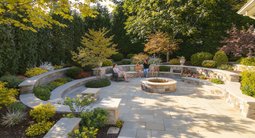TL;DR
Gardens that welcome bees, butterflies, birds, and frogs will also show us the cycle of life up close. This guide shares compassionate, wildlife‑friendly backyard design strategies, including how to plan a drought‑tolerant front yard and build a pollinator garden that nourishes more life than it loses.
Introduction

A tired honeybee rests on an aster bloom, symbolizing the gentle cycles in a wildlife-friendly garden.
Most worker honeybees live 4–6 weeks in summer, while long‑lived “winter bees” can persist 4–6 months when colonies cluster for warmth. That single fact can change how we feel when we notice a tired bee in October clinging to an aster bloom.
Across the country, homeowners are replacing thirsty lawns with native landscaping, container gardening, and wildlife‑friendly backyard design. The rewards arrive quickly: more bees, butterflies, birdsong, and small dramas among the stems. The sadness can arrive too, especially in fall, when short‑lived creatures finish their work. Gardeners who make room for life will sometimes find it resting for the last time among their flowers.
Here’s the quiet lesson: a living, eco‑friendly yard balances habitat, water, and seasonality so the next generation thrives. When we design for that, grief becomes a guide, not a stopper.
From Grief To Design: A Theme For Wildlife‑Friendly Gardens
Healthy ecosystems rely on turnover, and a wildlife‑friendly garden spreads resources across spring, summer, and fall so every life stage can find what it needs. Think of it as backyard garden ideas braided together: a pollinator patch, clean water, night‑friendly lighting, pesticide‑free pest control, and places to shelter over winter.
Within this theme are practical moves that build resilience right away. Native plants anchor bloom from April through frost, container gardening fills gaps on small patios, and drought‑tolerant planting reduces stress on pollinators by keeping nectar flowing through heat waves. In field visits, I’ve watched late rosemary in Zone 7 feed bees deep into November, while a shallow pebble dish turned a bare patio into a buzzing rest stop within days. The throughline is the same: design small, steady supports, then let the garden do the heavy lifting.
Anecdote
Field note: In Zone 8b, I walked a street where late‑flowering rosemary and salvias fed honeybees into November; a simple pebble dish in one yard became the block’s busiest refueling station after three dry weeks.
8 Ideas For A Wildlife‑Friendly, Low‑Impact Landscape
01. The Native Pollinator Patch
Clumping three to five native perennials at 12–18 inches apart creates stronger color blocks that help bees and butterflies navigate.
What it is: A concentrated bed of nectar and pollen plants timed to bloom in succession from early spring through fall.
How it works: Horticulturists note that continuous bloom is habitat’s heartbeat. Plant early starters like golden ragwort or penstemon, summer anchors like coneflower and bee balm, and fall workhorses like asters and goldenrod. Grouping species in small drifts makes for efficient foraging and better curb appeal. In full sun, most pollinator perennials want at least six hours of direct light per day. Aim for one square yard of blooms per 100 square feet of yard as a starter goal.
- Choose 5–7 native species suited to your USDA zone, then repeat them in clusters.
- Include at least one plant for each season: spring, summer, fall.
- Leave stems 12–24 inches tall over winter for cavity‑nesting bees.
Alt text idea: close‑up of a honeybee on purple aster in late fall.
02. A Bee‑Safe Water Station
Foraging pollinators dehydrate quickly in heat, and a water dish under 1 inch deep with landing stones prevents drowning.
What it is: A shallow basin with pebbles or corks that gives bees, butterflies, and small birds safe access to water.
How it works: Set a ceramic saucer or birdbath in bright but not blazing sun, fill with clean water to just cover the stones, and refresh every 2–3 days, daily above 85°F. Add a pinch of sea salt once a week; tiny mineral traces mimic natural puddles. Position 10–15 feet from the busiest flower bed to reduce crowding and predator pressure.
- Use a 10–14 inch saucer with mixed river stones for stable footing.
- Place near a shrub for quick cover; clean with a 1:10 vinegar rinse weekly.
- Add a floating wine cork or two as extra “life rafts.”
03. The Leave‑the‑Leaves Shift
Delaying spring cleanup until a five‑day stretch above 50°F allows overwintering bees, butterflies, and fireflies to emerge safely.
What it is: A seasonal maintenance pivot that treats leaves and hollow stems as vital habitat, not yard waste.
How it works: Many beneficial insects overwinter in leaf litter, duff, and spent stems. Rake leaves onto beds as a two‑inch mulch, not into bags. Cut perennials back in late spring, not fall. When you do cut, stack stems loosely along a fence so any late risers can exit. This practice reduces green‑waste hauling and can save up to 30% in irrigation thanks to improved soil moisture.
- Mulch beds with shredded leaves at 1–2 inches; keep 3 inches away from crowns.
- Wait to tidy until consistent 50°F days; watch for emerging natives before cutting.
- Compost extra leaves with a 3:1 brown‑to‑green ratio to speed breakdown.
4. Habitat Homes for Solitary Bees
Proper nesting tubes are 5/16 inch (8 mm) wide and at least 6 inches deep, mounted 3–6 feet high facing southeast.
What it is: Mason bee and leafcutter bee housing made of replaceable paper liners, reeds, or routed blocks.
How it works: Solitary bees are gentle, efficient pollinators that raise offspring in individual tubes. Place houses under an eave to stay dry, within 300 feet of nectar plants, and provide a damp clay patch for mason bees. Replace or sanitize nesting materials annually to prevent pests. In cool climates, cocoons are refrigerated around 39°F to time spring release with bloom.
- Mount houses on a stable wall, not a tree branch that sways.
- Offer clay or mud nearby; avoid pesticide use within 100 feet.
- Swap liners each year and freeze them for 48 hours before storage.
05. Pesticide‑Free Pest Balance
Integrated Pest Management (IPM) starts with monitoring and tolerance thresholds, and it solves 80–90% of issues without sprays.
What it is: A stepwise approach that favors hand removal, habitat for predators, and targeted controls as a last resort.
How it works: Most insects in an eco‑friendly yard are benign or beneficial. Encourage lacewings, hoverflies, lady beetles, and small wasps with diverse blooms and no broad‑spectrum insecticides. If intervention is needed, treat at dawn, spot‑apply, and avoid open flowers. Skip mosquito yard fogging, which research shows can kill non‑target pollinators far beyond property lines.
- Scout weekly; treat only when damage exceeds 10–15% of a plant’s canopy.
- Plant umbel flowers (dill, yarrow) to feed tiny predator wasps.
- Use row covers for brassicas at 0.5 mm mesh to block cabbage moths.
06. Night‑Friendly Lighting
Switching to 2700K LEDs with motion sensors reduces insect disorientation and supports night‑pollinating moths.
What it is: A lighting plan that preserves dark hours while maintaining safety and curb appeal.
How it works: Moths, beetles, and bats navigate by subtle light cues. Warm‑white fixtures aimed downward, set on timers or sensors, protect these nocturnal workers. Turn decorative lights off by 11 p.m. to cut energy use and skyglow. In my walk‑throughs, even a single shielded sconce near the patio made night activity noticeably calmer.
- Choose 2700K fixtures, fully shielded, with motion activation.
- Place path lights 12–18 inches high, spaced 6–8 feet apart.
- Set a hard “lights‑out” time to protect night pollinators.
07. The Container Meadow for Small Patios
Four large containers, each 14–20 inches wide, can host a full season of nectar in just 12–18 square feet.
What it is: A portable meadow using pots and planters that suits balconies, rentals, and tight townhome entries.
How it works: Combine drought‑tolerant natives and pollinator annuals in deep containers with a peat‑free mix. Place in 6+ hours of sun and irrigate with a slow 1–2 gallons per week per pot during summer. Designers often suggest repeating colors for cohesion and grouping pots in triangles for easy access by bees.
- Try prairie dropseed with purple coneflower and black‑eyed Susan.
- Add long bloomers like lantana or verbena for constant nectar.
- Elevate on pot feet for drainage; top‑dress with 1 inch compost in spring.
08. Gentle Care for End‑of‑Season Visitors
Sugar water at a 1:1 ratio is only for a cold, exhausted bee and should not be a routine food source.
What it is: Simple, compassionate triage that helps a struggling insect without disrupting natural foraging.
How it works: If a bee is sluggish on a cool day, move it to a sunny flower or a sheltered leaf and wait 10 minutes. If still immobile, offer a drop of 1:1 white sugar and water on a spoon, never honey, which can transmit disease. Many will warm and fly; some are simply at life’s end. Either way, you have given safe shelter.
- Relocate gently to a nectar plant; avoid handling wings.
- Offer one drop of 1:1 sugar water only when necessary.
- Leave spent blooms standing so the last nectar is easy to find.
A Short Reflection
The beauty of modern gardening isn’t control, it’s participation. Every flower you plant is a small vote for life, and every quiet farewell under a sunflower is part of that same promise.
Field note: I’ve seen gardeners in dry high desert towns build pebble water dishes and watch swallowtails sip in August heat. In a rainy Northwest courtyard, a single mason bee house turned spring mornings into a soft hum. Different climates, same result — care multiplied.
How To Visualize Your Space Before You Plant
Mapping beds to sunlight hours, bloom windows, and paths before planting saves seasons of trial and error, especially in small spaces.
Before you drop a shovel, sketch your space digitally. Platforms like ReimagineHome let you preview native plant palettes, container gardening layouts, and backyard design options. See where a 4x8 pollinator bed fits, test a drought‑tolerant front yard against your south exposure, and adjust pathways so you can weed and water without trampling seedlings. It turns good intentions into a living blueprint.
Visualization Scenario
A townhome patio with four 16‑inch planters becomes a container meadow; a 4x8 native pollinator bed replaces a strip of lawn along the front walk; a mason bee house faces southeast under the porch eave. Using ReimagineHome, the homeowner tests two bloom sequences and shifts the water dish 12 feet from the busiest flowers to reduce crowding.
FAQ: People Also Ask
How do you design a low‑maintenance, wildlife‑friendly garden?
Use native plants grouped in clusters, mulch with leaves at 1–2 inches, and install drip irrigation at 0.5–1 inch of water per week. This backyard garden idea reduces weeding and keeps a pollinator garden thriving with minimal inputs.
What plants support bees from spring to fall?
In many USDA zones, pair spring penstemon and phlox, summer bee balm and coneflower, and fall asters and goldenrod. Designers often suggest at least one nectar plant per season for a bee‑friendly garden.
When should fall cleanup happen for native landscaping?
Delay major cleanup until a five‑day stretch above 50°F in spring to protect overwintering insects. Cut stems in late spring and leave some 12–24 inches tall for nesting.
How to plan a drought‑tolerant front yard?
Replace 50–70% of turf with native grasses, shrubs, and gravel mulch, then water deeply but infrequently. Aim for plant spacing of 18–30 inches and use drip lines to cut water use by up to 50%.
What’s the best low‑maintenance plant mix for small patios?
Use 14–20 inch containers with prairie grasses, coneflower, and lantana for continuous bloom. Container gardening with peat‑free mix and weekly deep watering keeps care simple.
Is sugar water okay for tired bees?
Only as a one‑time aid for a cold or exhausted bee, using a 1:1 sugar‑to‑water ratio on a spoon. It should not replace natural nectar in a pollinator garden.
Closing Reflection
Grief shows up in healthy gardens because life does. When a bee sleeps on a final aster or a mantis settles into a stem for the last time, the garden is doing what it promised — feeding, sheltering, and returning everything to soil so next year has a chance. Design for that cycle and you’ll feel the difference: less anxiety about perfection, more gratitude for participation.
This season, plant for bloom in three acts, keep water clean and shallow, dim the lights, and leave some leaves where they fall. Your eco‑friendly yard will become a sanctuary where countless small lives begin, and where a few of them end, softly, among friends.
.svg)

.svg)










.png)